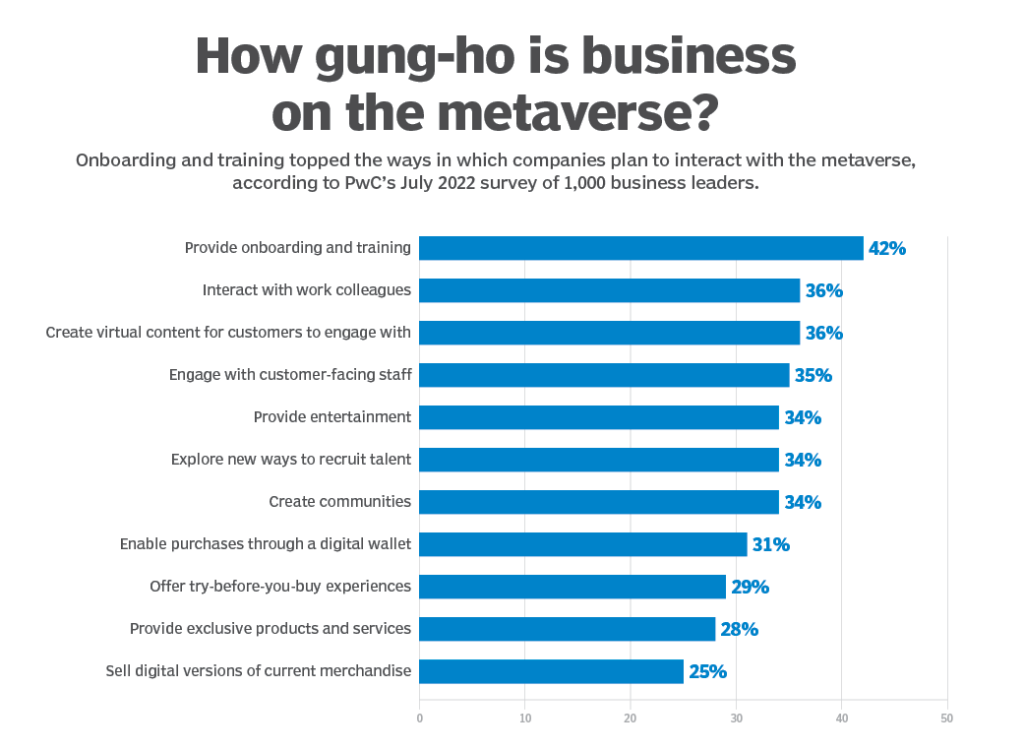The Metaverse – Innovate or Die?
What is the Metaverse?
The metaverse is a term which describes a collection of virtual worlds that we can work, play, explore and collaborate in. Whilst the term has become a popular buzz word of late, the name ‘metaverse’, itself, comes from Neal Stephenson’s 1992 science fiction novel Snow Crash, a book which envisioned a virtual world in which people would use avatars to interact with each other. Similar, is Stephen Spielberg’s more recent 2018 movie Ready Player One, which saw individuals find salvation from the chaos of reality in the virtual world: OASIS. Currently, there are multiple metaverse platforms in use, all with incredibly different interfaces, user bases and access credentials. The aspirational term ‘metaverse’, refers to an all-encompassing decentralised virtual world, rich in offering, interoperable and governed by the community.
The powerful combination of the emergence of 5G, offering us the infrastructure and connectivity needed for access, the advance of computing and processing power needed for availability and affordability, powerful blockchain technologies, in addition to the seismic emergence of cryptocurrencies, NFT’s, wallets and exchanges, means that a new Goldilocks zone has emerged, whereby the conditions for an entirely new economy to thrive within the metaverse are just right. Enter, Web 3.0.
How can companies leverage the Metaverse now?
“The metaverse will likely infiltrate every sector in some way in the coming years, with the market opportunity estimated at over $1 trillion in yearly revenues.” J.P Morgan
As with previous technology paradigm shifts, such as the birth of the internet, the metaverse is poised to transform almost every aspect of society. So, as we sit at the edge of the Web3 precipice, it is important for companies to understand, accept and embrace the new technology epoch and how they can fully leverage its presence.
Five key areas to currently observe: Talent Acquisition, Branding, Digital Products, Training and Work Structure.
1. Talent Acquisition
With driving demand and heavy investment being placed into the technological infrastructure of companies, there has been an uplift in the talent demand for many of these skilled roles. Jeremy Dalton, global director of metaverse technologies for PwC, said: “For recruitment, we are already using a metaverse platform, Virtual Park, to interview job candidates and offer them the ability to meet our people and find out more about our culture, values and opportunities”, since launching two years ago, they have reached roughly 20,000 users, a much wider talent pool than could have typically been accessed previously.
2. Branding
The social side of the metaverse is just as vital as the commercial side. Consumers will soon be able to make purchases of goods and services (including land) in both the physical world and the metaverse. Brand loyalty will become increasingly dependent on how well a company adapts and translates their current offerings onto the metaverse. As with all major technological shifts, the metaverse will gain traction slowly over time, 3D imaging for example, made its debut in the late 1800s, as well as games like Second Life, an alternate-reality video game which took 4 years to get its base to a million users (Fortnite then built upon this and after initial release in 2017 is now used by roughly 125m users worldwide). The metaverse will force companies to consider how their brand appeals to early adopters and stays relevant to their traditional customer base. This could have major implications on how a company defines and markets themselves to potential customers.
3. Digital Products
One of the ways multiple businesses are enriching the consumer experience of their brand via the metaverse, is by creating digital products and therefore generating new revenue streams. Luxury fashion brand Gucci opened a virtual space ‘Gucci Garden’, based on the philosophy of their creative director, Alessandro Michele and went on to sell a digital version of their ‘Queen Bee Dionysus’ bag on the Roblox marketplace for $4,115, more than the price of the bag’s real-world equivalent of roughly $3400.
Nike, a leading brand in the metaverse, acquired a non-fungible token studio, RTFKT, that produces digital collectibles (including digital sneakers) to merge culture and gaming. Previously RTFKT collaborated with teenage artist FEWOCiOUS to sell real sneakers paired with virtual ones, selling 600 pairs and NFT’s in six minutes and netting over $3.1 million. In addition to NFT’s, events are also able to be held in the space and are quickly gathering momentum; fashion shows, book launches and film premieres are all possibilities. In 2020, hip-hop star Travis Scott, earned millions of dollars by his avatar appearing on Fortnite, performing in concert and then sold virtual goods around it such as Travis Scott gaming skins.
4. Training/development
The rise of virtual and augmented reality has made huge waves within the gaming world, one popular example being Pokemon Go, and Anthony Wong, marketing director of Attensi (gamified solution training), believes that the same principles used for gaming, can be applied to learning and development in workplace training. Adding this new dimension to information sharing could transform business processes from onboarding sessions to simulation training/testing for complex practical roles. L&D practitioners will now need to be mindful of up to four generations, all equipped with multiple learning styles and consider how best to encourage fun, fast and ultimately more fruitful learning, essential in maximising growth potential.
5. Work Structure
Post covid, the majority of companies have moved to a hybrid structure of working, with many meetings and collaborations taking place across multiple technology platforms. The emergence of the metaverse could see companies pivot again, interacting using hands-free devices, avatars and new tools rather than only laptops and phones.
Frank Diana, managing partner and futurist at Tata Consultancy Services (TCS), likens the workplace shift to the metaverse to the transition from typing pools to having an entire workforce typing into personal computers. “What if there are boundary-less 3D collaboration tools in the metaverse and the team could transport themselves to the Louvre Museum for inspiration?” Diana asked. “If working remotely in the metaverse provides both increased productivity and better collaboration, today’s office model gets totally upended.”
Matterport, a tech company whose 3D modelling software digitally replicates physical spaces, has been developing digital twin workflows that lets employees collaborate, learn and engage remotely. For example, architects can virtually collaborate with clients by remodelling ideas to make faster decisions, retailers can virtually collaborate on store layouts to discover problems or opportunities sooner. Current 2D models of working are posed to advance with haste to 3D virtual environments, allowing workers to interact in immersive ways, consumer relationships to develop and companies to foster their company culture.

Whilst it’s easy to assume the metaverse is a faraway galaxy when compared to our immediate reality, many companies are already harnessing its power and proving the benefits of virtual worlds. Zwift for example, an MMO cycling game meets training tool established in 2014, has a 4 million subscriber base and through use of minimal kit; a bike, smart trainer and viewing device such as your phone or TV, riders can move through virtual imaginings of real-world routes across cities like London and New York and can also ride through the imagined worlds built by Zwift, such as Watopia.
Riders can input their height and weight data and this in addition to ANT+ and Bluetooth connectivity, then allows Zwift to calculate performance and show standings in comparison to other users. Since 2016, the company has also held world championships which have produced athletes who have gone on to secure real pro team contracts. Loes Adegeest, the 2022 winner, currently rides for UCI World Tour Team, ICBT and gained 5th place in general classification of the Lotto Belgium Tour. Zwift are proof that companies can both excel and profit by embracing virtual reality and their data sets around improvement to users health and social dynamics has cemented its status as a leading pioneer in the space.
Challenges and Risks firms face from the metaverse
Consider first, whether it makes sense to be engaging across these platforms. As the metaverse isn’t yet a single entity, but instead a collection of technologies, many would argue investing whilst still in its infancy could pose many financial and reputational risks to businesses. Privacy and safety concerns around hacking, impersonation and importantly, data use, rank highly among consumer fears, whilst the commercial, legal, and regulatory implications of the metaverse for businesses are enormous. If we were to take intellectual property, for example: What are the limits of IP, piracy, ownership, and patents in the virtual world? Are there digital land rights? How do brands deal with counterfeit digital products? Do you need a license to practice law in the metaverse?
This presents a new arena for hackers and new opportunities for criminal behaviour. How will misconduct be monitored, reported and remedied? What recourse do victims of avatar identity theft have? Are financial transactions protected? There is currently little regulation in place. Lastly, technical challenges such as computing power, interoperability and connectivity (bandwidth), present difficulties most companies simply aren’t ready nor equipped for. A true ecosystem of virtual worlds, where a person’s digital assets can be carried from one world to another, will require significant preparation and collaboration from large tech players, which could potentially conflict with their own nature.
That being said, the other end of the spectrum would be that companies face an even greater risk by failing to innovate. Similar to the Zuoara’s documentation of the mass extinction of companies who failed to embrace the “subscription economy”, innovation and the rapid progression of these technologies should not be ignored. A recent study by McKinsey found that the average lifespan of companies listed in Standard & Poor’s 500 was 61 years in 1958. Today, it is less than 18 years. McKinsey believes that, in 2027, 75% of the companies currently quoted on the S&P 500 will have disappeared.
In these evolving times, businesses are advised to exercise caution when investing in the metaverse and to facilitate early conversations between IT, compliance, legal, finance, and security.
How CACI can assist companies within the metaverse space
According to a recent Bloomberg report, the metaverse is on track to have a market size worth $678 Billion by 2030. For business, the implications of an immersive, persistent and decentralised digital world could be enormous. Since 1962, CACI has been aiding companies identify emerging technologies, utilise their strengths and build protective solutions from potential threats. Whilst the metaverse is still very much an evolution rather than a revolution, its foundational elements lay within connectivity, processing power, data storage and security. Drawing on the advanced capabilities of 25,000 skilled professionals worldwide, we offer a spectrum of services across the entire metaverse continuum to aid mission led enterprising companies in their pursuit of innovation:
- Cloud technology addresses processing power and storage to support extended reality and immersive interfaces
- Hyperconnected networks leverage the power of 5G
- Cyber Security solutions protect vital information
- Blockchain-based platforms to buy and trade in
- Business architecture and digital twin through our data visualisation platform
- Bespoke digital solutions that are designed, built and supported to meet your customer needs across the virtual landscape
- Customer Insights
- Service Design
- Governance
- Dark Web Analysis Technology

Source: PwC 2022 Business and consumer metaverse survey, July 2022
“…what attracts human attention is change. …if the temperature around you changes, if the phone rings — that gets your attention. The way in which a story begins is a starting event that creates a moment of change.” – Robert McKee
Contact us here to get in touch about any of our services.
Notes:
[1] Opportunities in the metaverse (jpmorgan.com)
[2] Metaverse Market Size Worth $678.8 Billion by 2030: Grand View Research, Inc. – Bloomberg
